Document Outline
- Main Menu
- Speech Products
- Search
- Web
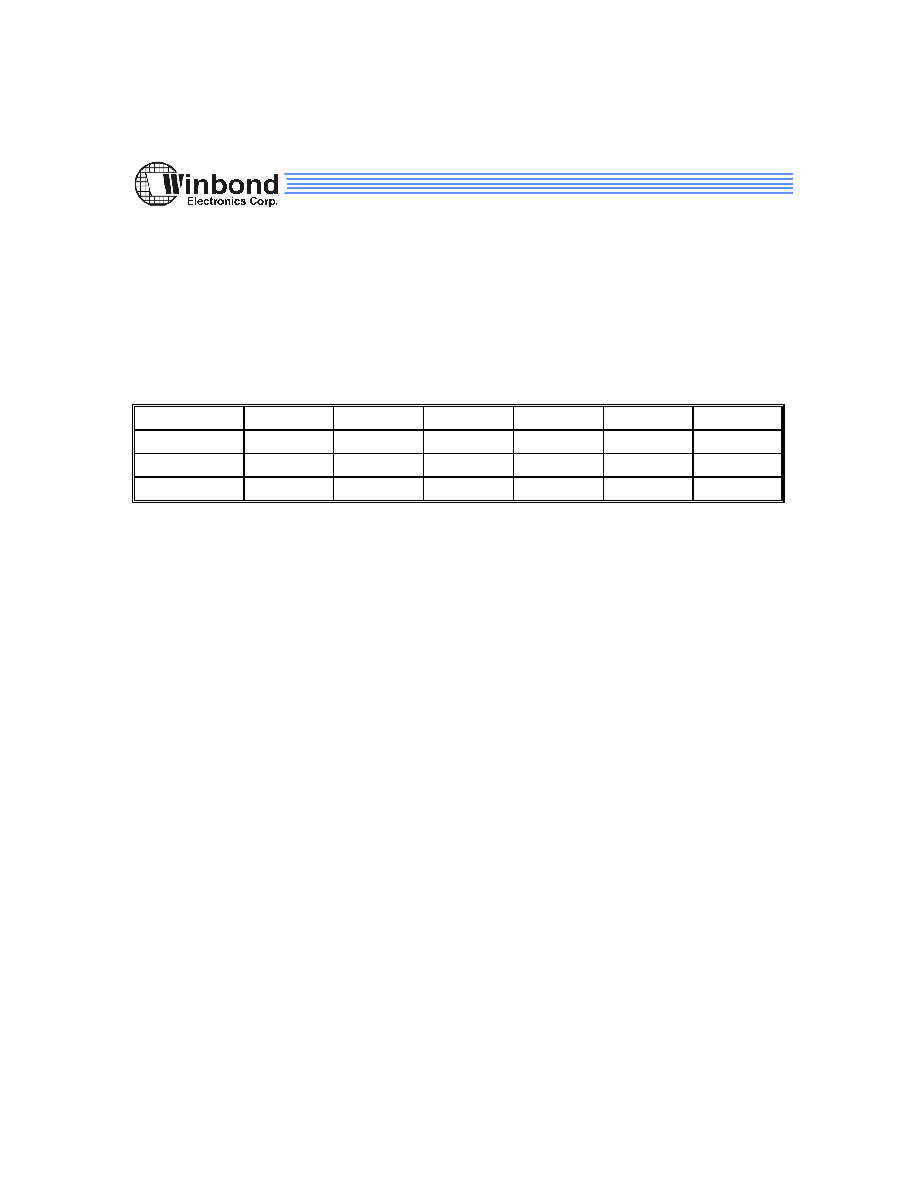
Preliminary W583XXX
HIGH FIDELITY
Power Speech
TM
Publication Release Date: March 1999
- 1 -
Revision A1
GENERAL DESCRIPTION
W583xxx are fabricated using the Winbond CMOS process. The W583xxx family is a new member of
the PowerSpeech
synthesizer series, with voice quality which is even better than before. The
W583xxx family has adopted the same architecture as the PowerSpeech
synthesizers while
replacing the 4-bit ADPCM algorithm with Winbond
s new high fidelity voice synthesis algorithm to
produce better quality voice. W583xxx provides IR function, CPU interface, pad option for Ring or
Crystal oscillator and voice output in DAC current or PWM type.
According different voice duration, there are 11 bodies in W583xxx family, list them below.
PART NO.
W583S10
W583S15
W583S20
W583S25
W583S30
W583S40
Duration
10 sec
15 sec
20 sec
25 sec
30 sec
40 sec
PART NO.
W583S50
W583S60
W583S80
W583S99
W583M02
Duration
50 sec
60 sec
80 sec
99 sec
120 sec
Notes:
1. The voice duration is estimated by 6.4 KHz sampling rate.
2. W583S10 provides less I/O pins, and do not provide crystal oscillator.
FEATURES
�
Programmable speech synthesizer
�
New high fidelity synthesis algorithm
�
Wide operating voltage range: 2.4 - 5.5 Volts
�
Direct drive speaker by PWM output or Built-in 8-bit D/A converter
�
Supports CPU interface operation
�
IR interface for command Transmission and Receiving
�
Symbolic compiler supported
�
Instruction cycle
400 �S typically
�
Section control
- Variable frequency: 4.8/6/8/12 KHz
- LED: ON/OFF
�
Eight general-purpose registers R0-R7
�
Pad option for Ring or Crystal oscillator
1
�
8 trigger inputs - with separate control of falling/rising edge trigger
2
�
8 STOP outputs
3
�
Number of interrupt vector / label up to 2,048
Notes:
1. W583S10 provide ring oscillator only.
2. Only 4 trigger pins in W583S10.
3. Only 5 STOP outputs in W583S10.
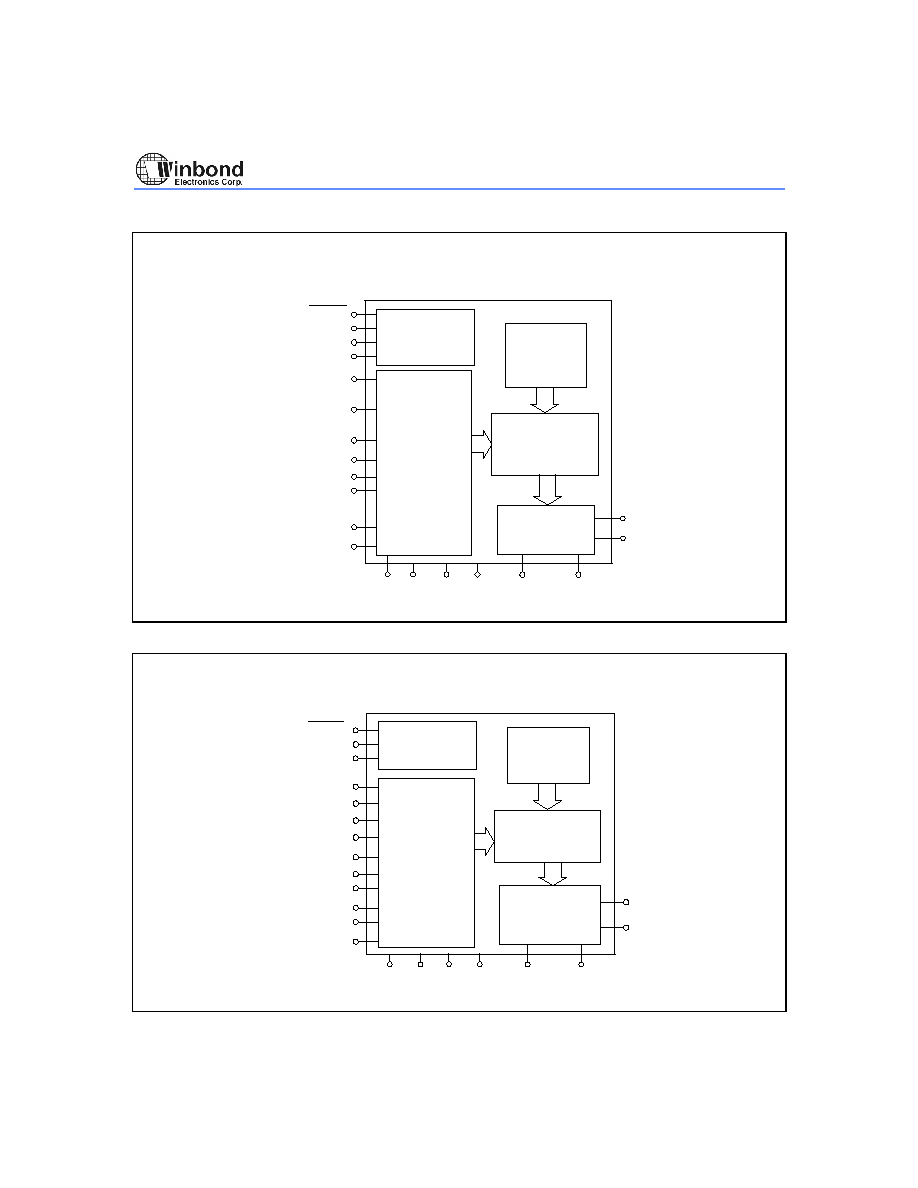
Preliminary W583XXX
- 2 -
BLOCK DIAGRAM
TIMING
GENERATOR
CONTROLLER
SPEECH
SYNTHESIZER
D/A CONVERTER
OSC/XIN
XOUT
SEL
TG1
TG3/IRIN
TG8
STPA/BUSY
STPH
LED1
AUD/SPK+ SPK-
ROM
LED2/STPC
STPB
PWM DRIVER
VDD VSS TEST
RESET
IROUT
:
:
:
VDD1
VSS1
W583S15 to W583M02
TIMING
GENERATOR
CONTROLLER
SPEECH
SYNTHESIZER
D/A
CONVERTER
OSC
OSCO
TG1
TG2
TG4
STPA/BUSY
STPE
LED1
AUD/SPK+
ROM
LED2/STPC
STPB
VDD VSS TEST
RESET
STPD
TG3/IRIN
SPK-
PWM DRIVER
VSS1
VDD1
IROUT
W583S10

Preliminary W583XXX
Publication Release Date: March 1999
- 3 -
Revision A1
PIN DESCRIPTION
NAME
I/O
DESCRIPTION
V
DD
-
Positive power supply
TEST
I
Test pin, internally pulled low
RESET
I
Reset all, functions as POR, internally pulled high
TG1
I
Direct trigger input 1, internally pulled high
TG2
I
Direct trigger input 2, internally pulled high
TG3/IRIN
I
Direct trigger input 3 or IR input, internally pulled high. Once this pin is
pulled low, the oscillation circuit is active even the chip enters standby
mode.
TG4
I
Direct trigger input 4, internally pulled high
V
SS
-
Negative power supply
LED1
O
LED1 output
IROUT
O
IR signal output pin, active low
STPA/BUSY
O
Stop signal A or Busy signal
STPB
O
Stop signal B
LED2/STPC
O
LED2 output or Stop signal C
STPD
O
Stop signal D
STPE
O
Stop signal E
AUD/SPK+
O
Current type output or PWM output for speaker
SPK-
O
PWM output
V
SS1
-
Negative power supply
V
DD1
-
Positive power supply
Pin Description only for W583S15 to W583M02
NAME
I/O
DESCRIPTION
OSC/XIN
I
Ring oscillator input or crystal input
XOUT
I/O
Crystal input or oscillator clock output
SEL
I
Ring/Crystal oscillator select, internally pulled high. Floating for Ring and
grounded for crystal.
TG5
I
Direct trigger input 5, internally pulled high
TG6
I
Direct trigger input 6, internally pulled high
TG7
I
Direct trigger input 7, internally pulled high
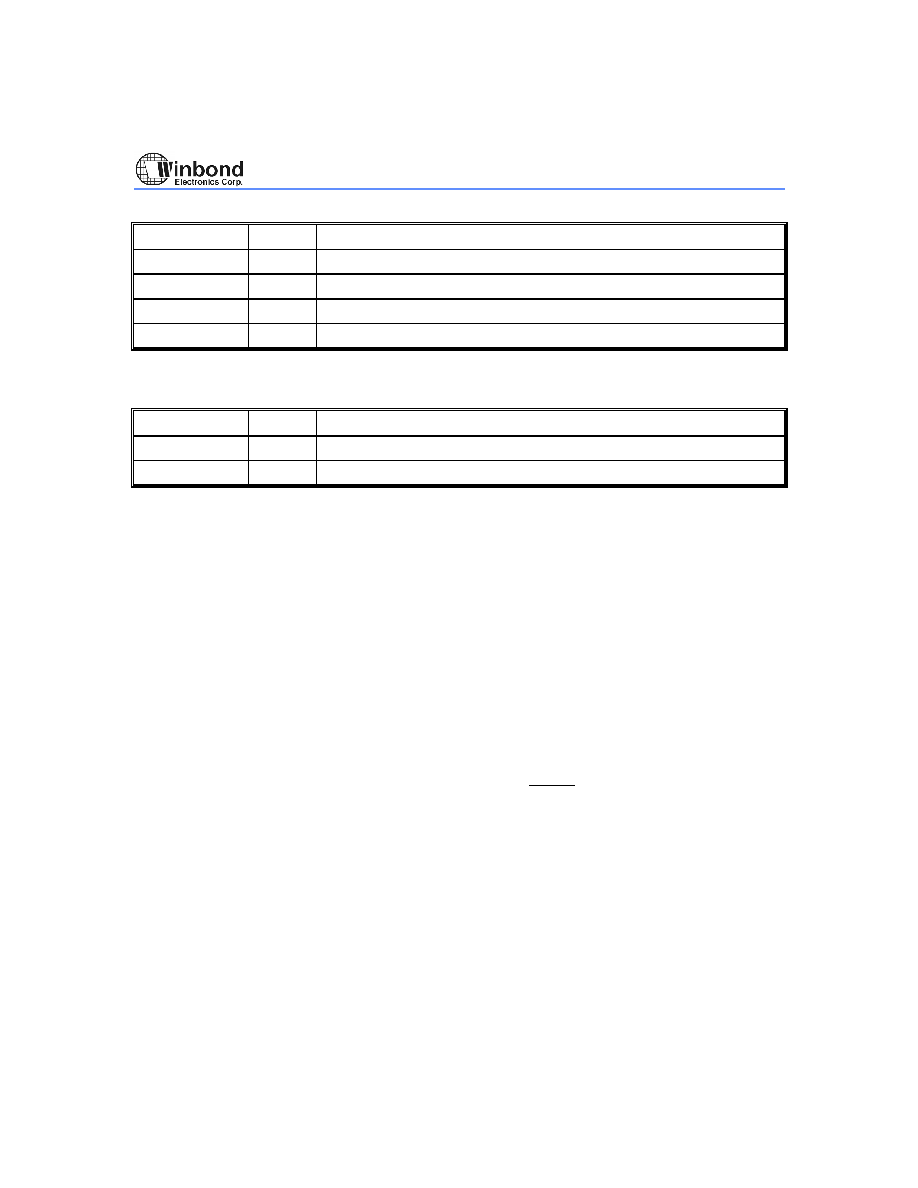
Preliminary W583XXX
- 4 -
Pin Description only for W583S15 to W583M02, continued
NAME
I/O
DESCRIPTION
TG8
I
Direct trigger input 8, internally pulled high
STPF
O
Stop signal F
STPG
O
Stop signal G
STPH
O
Stop signal H
Pin Description only for W583S10
NAME
I/O
DESCRIPTION
OSC
I
Ring oscillator input
OSCO
O
Oscillator clock output
FUNCTIONAL DESCRIPTION
The W583xxx is a derivative of Winbond's PowerSpeech
synthesizers, which are becoming
dominant in the consumer market, especially for toy applications.
There are up to 8 trigger inputs and 8 STOP outputs in W583xxx. The maximal number of software
key pad by scanning matrix is up to 8
� 9 = 72 keys. There are 8 general purpose registers, R0-R7.
R0-R7 can apply not only for "LD" and "JP" instructions but also for "MV" instruction. Only R0 can
apply for "INC" instruction. CPU interface is the same as the W581xx series.
IR interface is a new feature of PowerSpeech
. User can use IR interface to transmit and receive a
command. For example, when X chip executes the "TX R1" instruction, the Pulse Position Modulation
waveform (with 38 KHz carrier) outputs from IROUT pin to drive a photo diode. Y chips within a
certain distance will receive the IR signal through an IR receiver module to TG3/IRIN pin and execute
a "JP" instruction to the interrupt vector/label pointed by R1 of X chip.
There are two kinds of events that can cause the W583xxx to enter the POI (Power On Initialization)
process: one is power on, and the other is direct trigger from RESET pin. The interrupt vector "32" is
allocated for this special event, and its priority is above all, i.e., no triggers can override the POI
process if they all happen simultaneously. So the user can write a program into this interrupt vector to
set the power on initial state. If the user does not wish to execute a program on power on, he should
write an "END" instruction in interrupt vector "32". During the POI process, triggers can then override
it successfully; if the EN0, EN1 and MODE0, MODE1 registers are set properly.
If more than two events happen simultaneously, the priority that is set by the internal H/W is: POI >
TG1F > TG1R > TG2F > TG2R > TG3F > TG3R > TG4F > TG4R > TG5F > TG5R > TG6F > TG6R
> TG7F > TG7R > TG8F > TG8R > "JP" instruction.
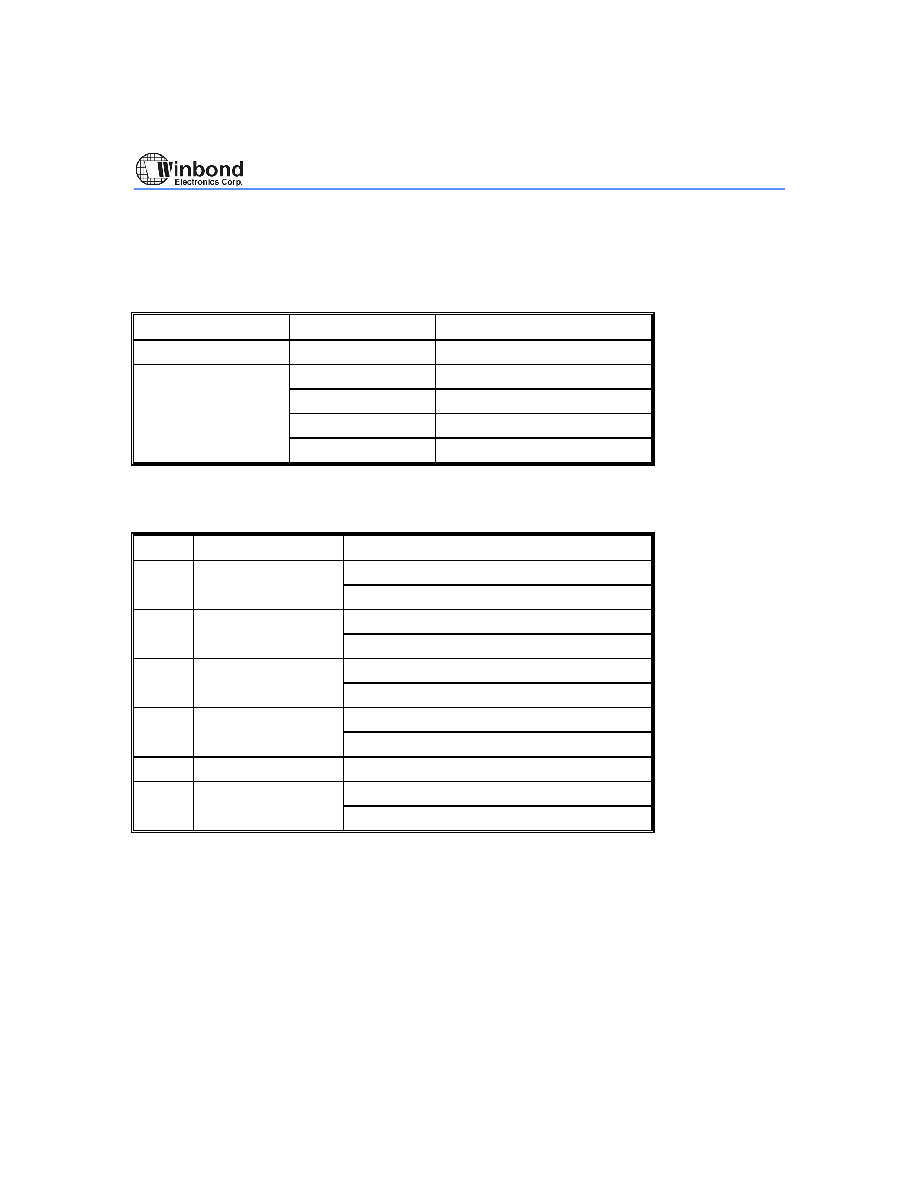
Preliminary W583XXX
Publication Release Date: March 1999
- 5 -
Revision A1
Register Definition And Control
The register file of the W583xxx family is composed of 14 registers, including 8 general purpose
registers and 6 special purpose registers.
They are defined to facilitate the operations for various purposes. The default setting values of the
registers are given in the following table.
REGISTER
NAME
DEFAULT SETTING
General Register
R0-R7
00100000B
EN0, EN1
11111111B
Special Register
MODE0, MODE1
11111111B
STOP
11111111B
PAGE
00000000B
Note: EN1 register and bits 5-7 of STOP register are not provided in W583S10.
1. MODE0 Register
BIT
DESCRIPTION
DEFINITION
7
LED mode
1: Flash
0: DC
6
LED2/STPC
1: LED2 output
pin selection
0: STPC output
5
IR output source
1: Hardware control IR output
0: STPC control IR output
4
Debounce time
1: Long
0: Short
3, 1, 0
Reserved
-
2
STPA/BUSY
1: STPA output
pin selection
0: BUSY output
MODE0.7 controls the output type of LED1 (and LED2) pin. MODE0.6 controls the configuration of
LED2/STPC pin. MODE0.5 controls the output source of IR. If hardware control IR output is selected,
IR output can have signal with carrier or without carrier which is selected by MODE1.0. MODE0.4
controls the trigger pin debounce time. MODE0.2 controls the behavior of the STPA/BUSY pin which
is usually used as Busy signal in CPU mode.
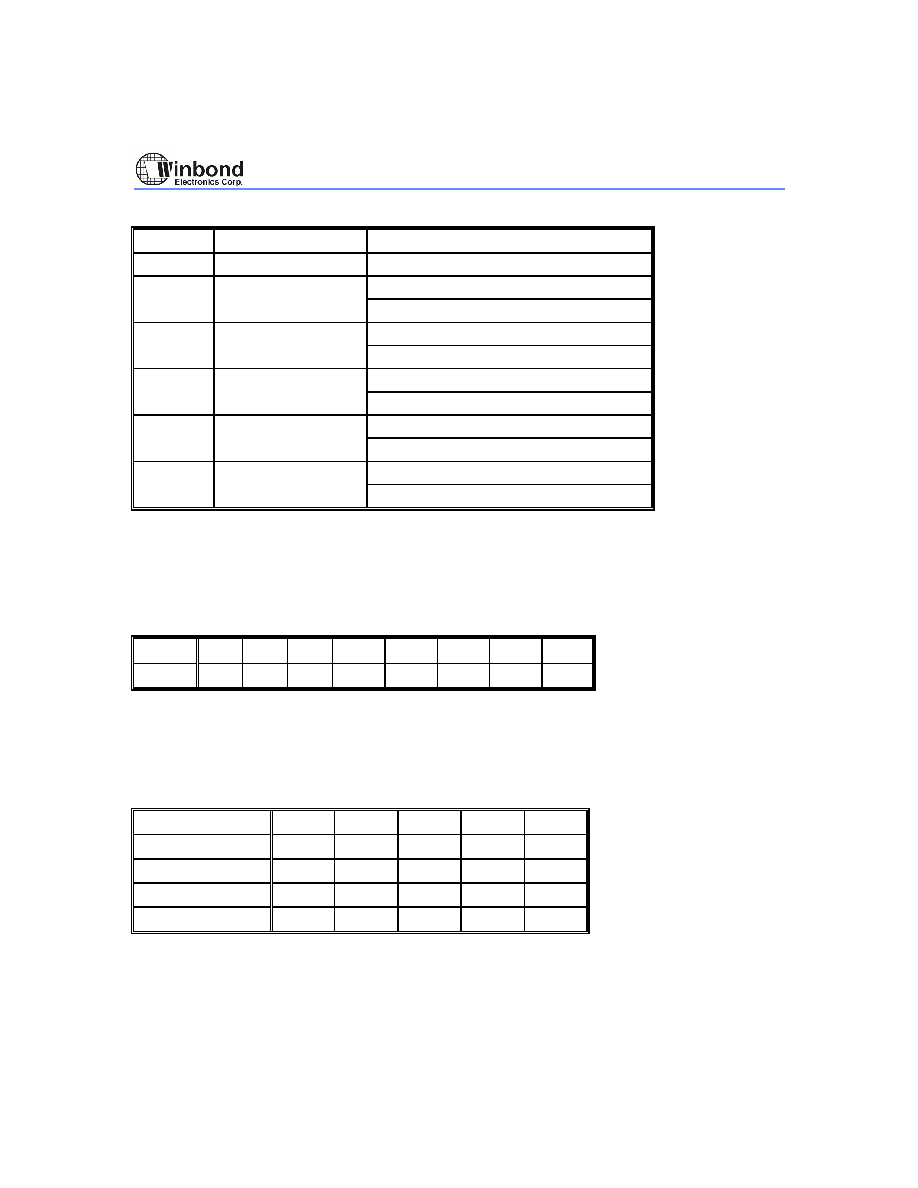
Preliminary W583XXX
- 6 -
2. MODE1 Register
BIT
DESCRIPTION
DEFINITION
7, 6, 1
Reserved
5
LED Flash Type
1: Alternate
0: Synchronous
4
LED1 Section
1: YES
Control
0: NO
3
LED2 Control
1: SECTION control
0: STPC control
2
LED1 Volume
1: Off
Control
0: On
0
IR Output Format
1: IR output carrier with duty cycle 75%
0: IR output without carrier
MODE1.5 is for LED flash type control. MODE1.4 is for LED1 section control ON/OFF. MODE1.3 is
for LED2 Section/STPC control. MODE1.2 is for LED1 volume control. MODE1.0 is for IR output with
or without carrier and this bit is useful only MODE0.5 is "1". For STPC control IR output (MODE0.5 is
0), the IR output always has 38 KHz carrier signal no matter what the setting of MODE1.0 is.
3. PAGE Register
BIT
7
6
5
4
3
2
1
0
PAGE
-
-
-
PG4
PG3
PG2
PG1
PG0
Bits 5-7 of PAGE register are reserved; bits 0-4 are used for page selection. The user must setup the
page mode configuration described in the Option Control Function section. Once the page mode is
decided, the working page is selected by the bits 0-4 of PAGE register. Hence, the user can execute
"LD PAGE, value" instruction to change the working page of the voice entry group. Not all of the bits
0-4 of PAGE register are used in different page mode; they are listed below.
PAGE MODE
PG4
PG3
PG2
PG1
PG0
1-page
�
�
�
�
�
8-page
�
�
16-page
�
32-page
Where "
�" means dont care and "" means must be set properly.
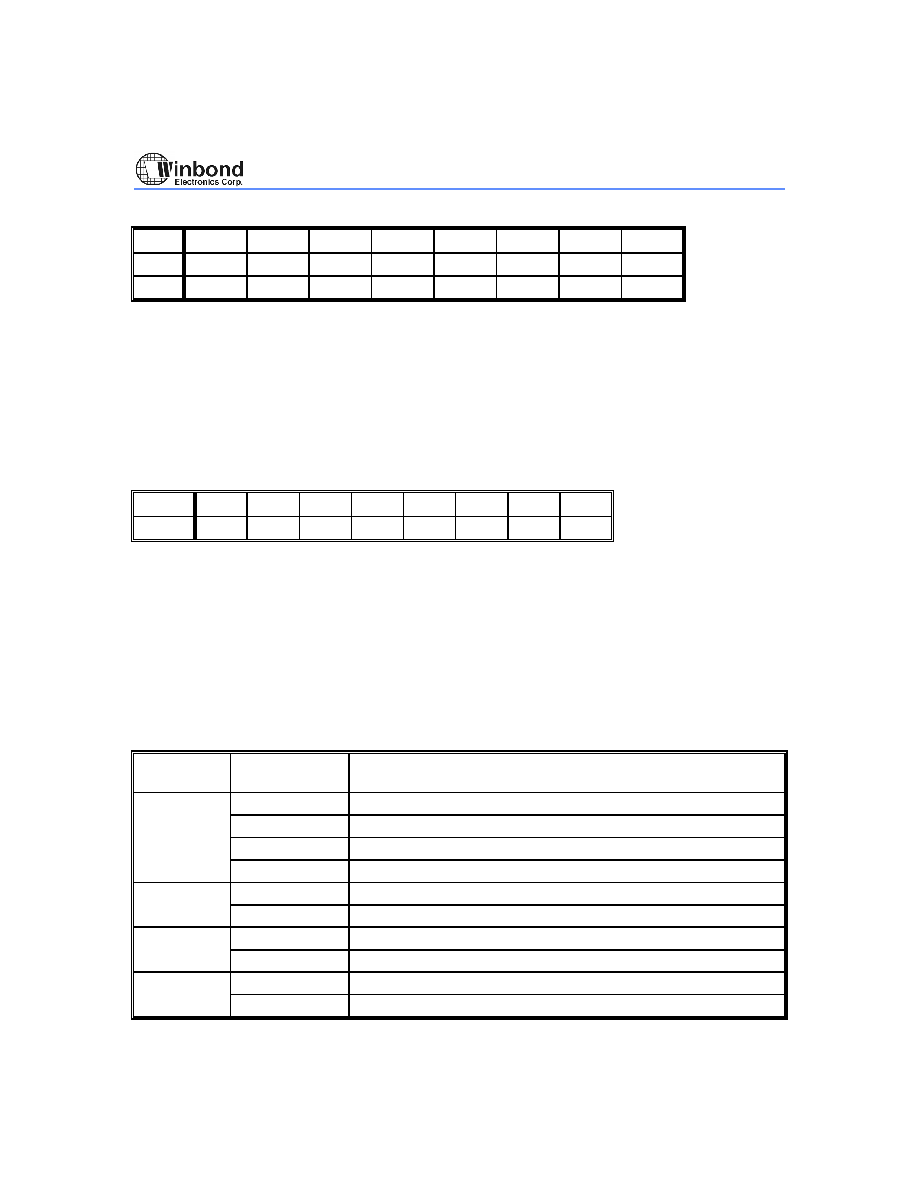
Preliminary W583XXX
Publication Release Date: March 1999
- 7 -
Revision A1
4. EN0, EN1 Registers
BIT
7
6
5
4
3
2
1
0
EN0
TG4R
TG3R
TG2R
TG1R
TG4F
TG3F
TG2F
TG1F
EN1
TG8R
TG7R
TG6R
TG5R
TG8F
TG7F
TG6F
TG5F
A "1" means "enabled", while a "0" means "disabled" for that edge of the particular TG pin. For
example, the instruction "LD EN0, 0x0F" enables all the falling edge triggers of TG1-TG4, while
disabling all the rising edge triggers of TG1-TG4. The user can modify the EN0 and EN1 registers
during operation of the W583xxx to achieve various kinds of trigger functions, like retriggerable or
not, one shot or level hold play mode, etc.
That is to say, users can change the contents of EN0, EN1 register during synthesis at will to
determine which trigger pin is to be enabled or disabled for its falling/rising edge.
EN1 register is not provided in W583S10.
5. STOP Register
BIT
7
6
5
4
3
2
1
0
STOP
STH
STG
STF
STE
STD
STC
STB
STA
The STOP register is used to control the status of the STPA-STPH pins. For example STB bit, the
corresponding bit 1 of the STOP register is used to drive the output buffer of STPB pin, an inverted
stage, to show its logic status. Notes that bits 5-7 of STOP register are reserved in W583S10.
6. R0-R7 Registers
These eight registers function as general purpose registers. They can be used to hold interrupt
vector/label. R0 is a special register which can be incremented by "INC" instruction.
Option Control Function
There are four types of option control in W583xxx. They can be determined by a declaration in the
user
s program file, but can not be controlled by register.
FUNCTION
MASK OPTION
DECLARATION
DEFINITION
DEFPAGE 1
256 interrupt vector/label for 1 page, 1 page in total (1-page mode)
Page Mode
DEFPAGE 8
256 interrupt vector/label for 1 page, 8 pages in total (8-page mode)
Configuration
DEFPAGE 16
128 interrupt vector/label for 1 page, 16 pages in total (16-page mode)
DEFPAGE 32
64 interrupt vector/label for 1 page, 32 pages in total (32-page mode)
Operation
NORMAL
Normal mode operation
Mode
CPU
CPU mode operation
Oscillator
OSC_3MHz
3 MHz oscillator
Frequency
OSC_1.5MHz
1.5 MHz oscillator
Voice
VOUT_DAC
DAC (AUD) output
Output Type
VOUT_PWM
PWM output
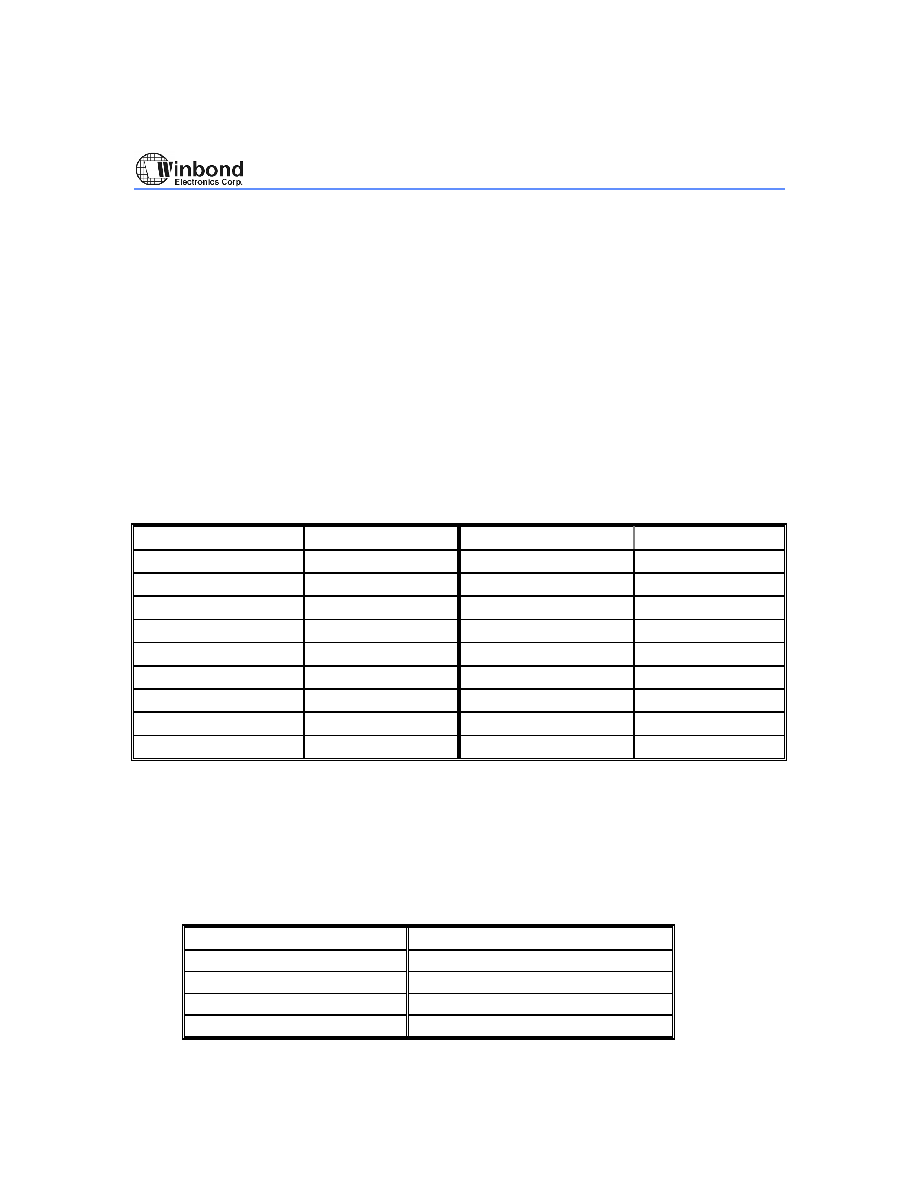
Preliminary W583XXX
- 8 -
"DEFPAGE" decides the page operation mode of W583xxx. The default setting of the page mode is
1-page mode. The 8-page, 16-page or 32-page mode must be declared in order to reach the interrupt
vector/label from 256 to 2047 when the interrupt vector/label is beyond 0-255.
The W583xxx can communicate with an external microprocessor through the simple serial CPU
interface, which is the same as the W581xx series. The CPU interface consists of the TG1, TG2, and
STPA/BUSY pins. "NORMAL" and "CPU" decide whether the operation mode of W583xxx will be
normal mode or CPU mode.
"OSC_3MHz" and "OSC_1.5MHz" select the frequency of the system clock. "VOUT_DAC" and
"VOUT_PWM" select the voice output type.
Interrupt Vector Allocation
The W583xxx provides a total of 8 trigger inputs to communicate with the outside world. Each trigger
pin can invoke 2 dedicate interrupt vectors depending on TG pin status. The table below show the
relationship between TG pin status and interrupt vectors.
Interrupt vectors 8-15 are not allocated for TG pins in W583S10 because only TG1-TG4 pins are
provided in this chip.
INTERRUPT VECTOR
TRIGGER SOURCE
INTERRUPT VECTOR
TRIGGER SOURCE
0
TG1F
8
TG5F
1
TG2F
9
TG6F
2
TG3F
10
TG7F
3
TG4F
11
TG8F
4
TG1R
12
TG5R
5
TG2R
13
TG6R
6
TG3R
14
TG7R
7
TG4R
15
TG8R
32
POI
-
-
Instruction Set
There are two types of instruction in the W583xxx, unconditional and conditional instructions. The first
type of instructions are executed immediately after they are issued. The second type of instructions
are executed only when the conditions specified in the instruction are satisfied. All the instructions are
listed in the following table.
The cycle time for each instruction is 2/Sampling Frequency(Fs). For Fs = 6.0 KHz, the cycle time is
333
�S.
UNCONDITIONAL
CONDITIONAL
JP
G
JP
G
@STS
JP
Rn
JP
Rn
@STS
LD
EN0, value
LD
EN0, value
@STS
*
LD
EN1, value
*
LD
EN1, value
@STS

Preliminary W583XXX
Publication Release Date: March 1999
- 9 -
Revision A1
Continued
LD
MODEi, value
LD
MODEi, value
@STS
LD
STOP, value
LD
STOP, value
@STS
LD
PAGE, value
LD
PAGE, value
@STS
LD
Rn, value
LD
Rn, value
@STS
END
END
@STS
MV
Rn, Rm
MV
Rn, Rm
@STS
INC
INC
@STS
TX
Rn
TX
Rn
@STS
Legend:
G: Interrupt vector/label
Rn: R0-R7
Rm: R0-R7
MODEi: MODE0, MODE1
value: 8-bit data
@STS can be the following: @LAST, @TGn_HIGH, @TGn_LOW, n = 1
-8.
But n = 1
-4 for W583S10.
*: These instructions are not provided in W583S10.
ABSOLUTE MAXIMUM RATINGS
PARAMETER
SYMBOL
CONDITIONS
RATED VALUE
UNIT
Power Supply
V
DD
-V
SS
-
-0.3 to +7.0
V
Input Voltage
V
IN
All Inputs
V
SS
-0.3 to V
DD
+0.3
V
Storage Temp.
T
STG
-
-55 to +150
�C
Operating Temp.
T
OPR
-
0 to +70
�C
Note: Exposure to conditions beyond those listed under Absolute Maximum Ratings may adversely affect the life and reliability of the
device.
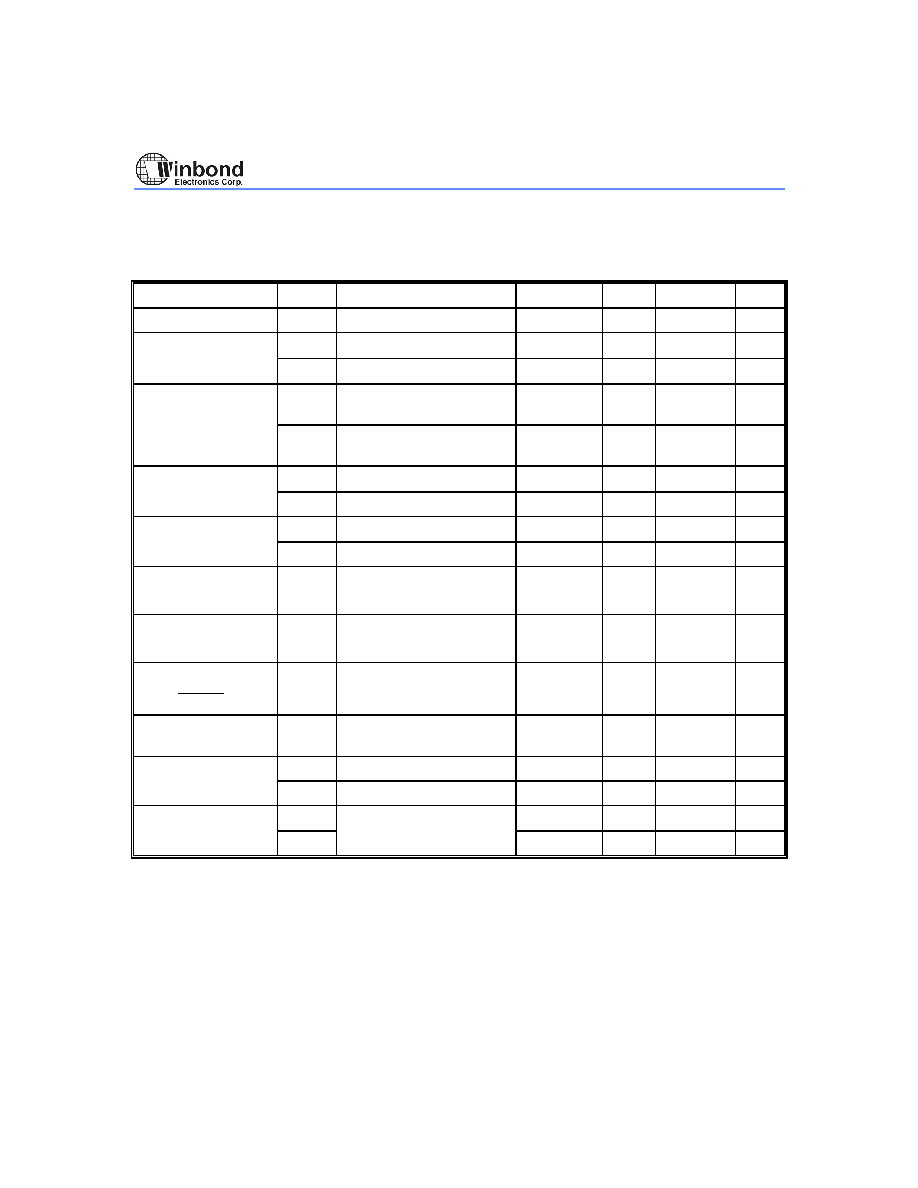
Preliminary W583XXX
- 10 -
ELECTRICAL CHARACTERISTICS
(T
A
= 25
� C, V
SS
= 0V, V
DD
= 4.5V unless otherwise specified.)
DC Characteristics
PARAMETER
SYM.
CONDITIONS
MIN.
TYP.
MAX.
UNIT
Operating Voltage
V
DD
2.4
3
5.5
V
Input Voltage
V
IL
V
SS
-0.3
-
0.3
� V
DD
V
V
IH
0.7
� V
DD
-
V
DD
Standby Current
I
SB1
V
DD
= 3V, All I/O pins
unconnected, No Playing
1
�A
I
SB2
V
DD
= 5V, All I/O pins
unconnected, No Playing
1
�A
Operating Current
I
OP1
V
DD
= 3V, No Load
500
�A
(Ring type)
I
OP2
V
DD
= 5V, No Load
1
mA
Operating Current
I
OP3
V
DD
= 3V, No Load
600
�A
(Crystal type)
I
OP4
V
DD
= 5V, No Load
1.2
mA
Input Current of
TG1-TG8 Pins
I
IN1
V
DD
= 3V, Vin = 0V
-8
�A
Input Current of
TEST Pin
I
IN2
V
DD
= 3V, Vin = 3V
50
�A
Input Current of
SEL, RESET
I
IN3
V
DD
= 3V, Vin = 0V
-8
�A
SPK (D/A Full
Scale)
I
DAC
V
DD
= 4.5V, Rl = 100
-4.0
-5.0
-6.0
mA
Output Current of
I
OL1
V
DD
= 3V, Vout = 0.4V
0.8
mA
STPA-STPH
I
OH1
V
DD
= 3V, Vout = 2.7V
-0.8
mA
Output Current of
I
OL2
V
DD
= 3V, Rl = 8
100
mA
SPK+, SPK-
I
OH2
-100
mA
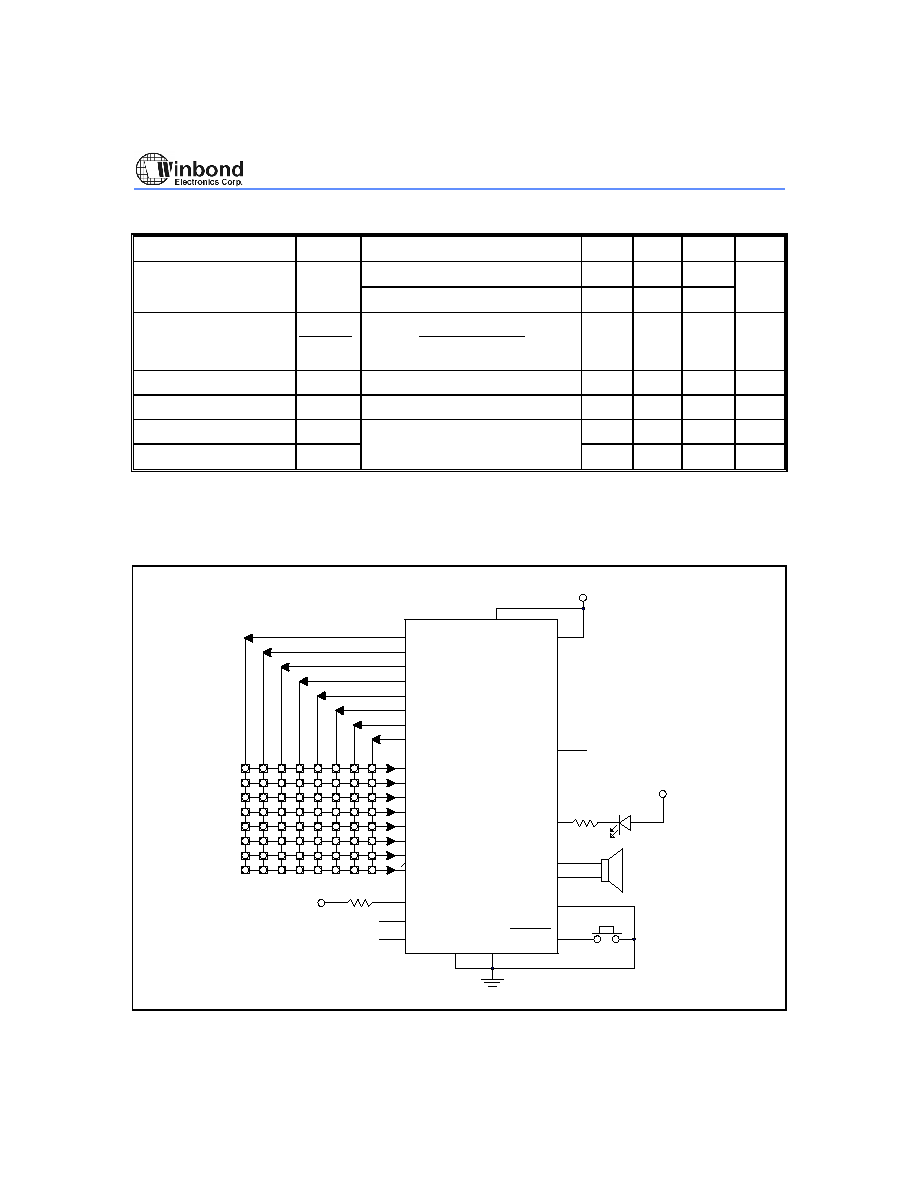
Preliminary W583XXX
Publication Release Date: March 1999
- 11 -
Revision A1
AC Characteristics
PARAMETER
SYM.
CONDITIONS
MIN.
TYP.
MAX.
UNIT
Oscillation Frequency
1
Fosc
Ring Oscillator, Rosc = 750 K
2.7
3
3.3
MHz
Ring Oscillator, Rosc = 1.6 M
1.3
1.5
1.7
Oscillation Frequency
Deviation by Voltage
Drop
Fosc
Fosc
F(3V)-F(2.4V)
F(3V)
7.5
%
Instruction Cycle Time
Tins
Fosc = 3 MHz, SR = 6 KHz
1/3
mS
POI Delay Time
T
PD
Fosc = 3 MHz
160
mS
Long Debounce Time
T
DEBL
Fosc = 3 MHz, SR = 6 KHz
50
mS
Short Debounce Time
2
T
DEBS
400
�S
1. This parameter is different from that of W58300.
2. For ring oscillator only.
TYPICAL APPLICATION CIRCUIT
Rosc
AUD/SPK+
SPK-
VSS
VCC
VDD
XOUT
OSC/XIN
W583S80
TG2
TG1
TG4
TG3/IRIN
TG6
TG5
TG8
TG7
STPA/BUSY
STPB
LED2/STPC
STPD
STPE
STPF
STPG
STPH
LED1
VCC
SEL
VDD1
TEST
IROUT
VSS1
VCC
RESET
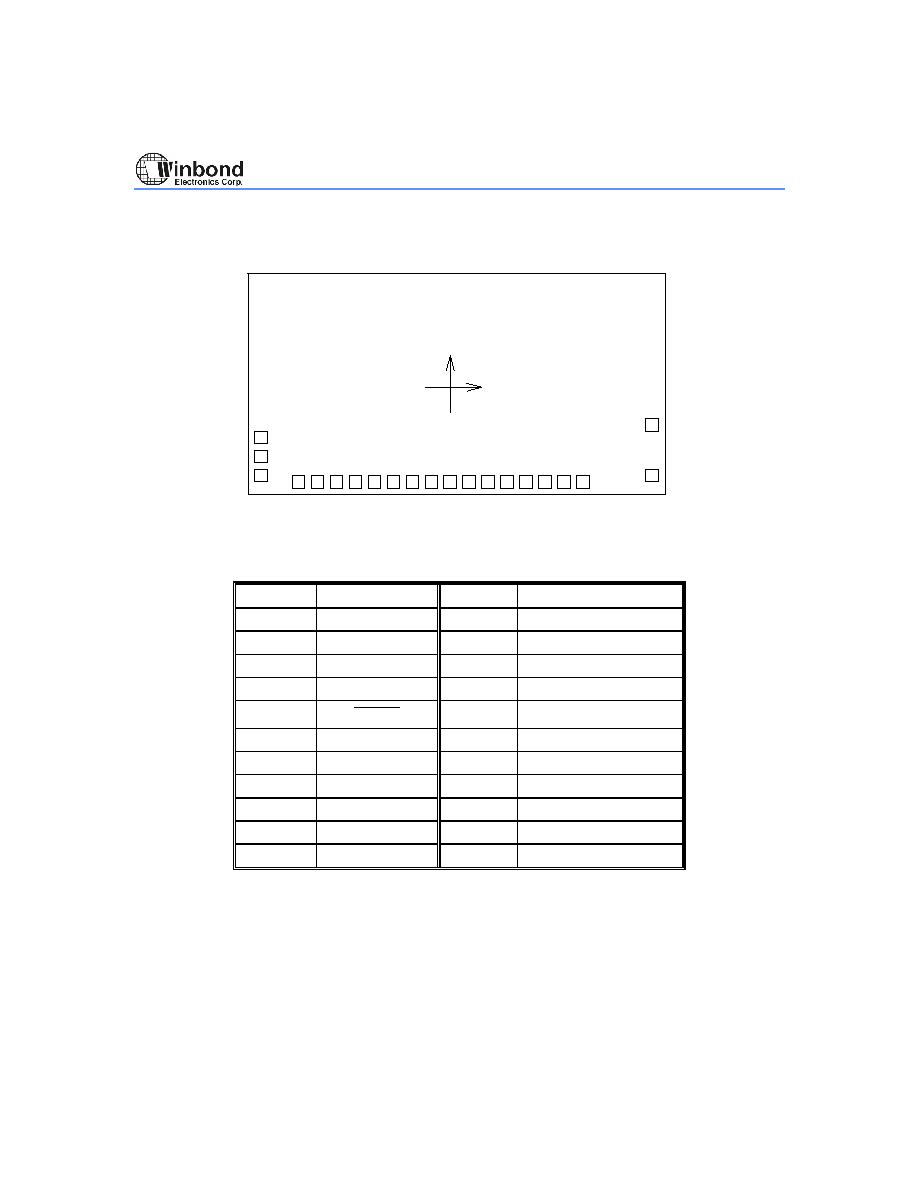
Preliminary W583XXX
- 12 -
BONDING PAD DIAGRAM
(For W583S10 only)
(0,0)
2
1
3
4
5
6
7
8
9 10 11 12 13 14 15 16 17 18 19
20
21
PAD NO.
PAD NAME
PAD NO.
PAD NAME
1
V
DD
12
LED1
2
OSC
13
STPA/BUSY
3
OSCO
14
STPB
4
TEST
15
LED2/STPC
5
RESET
16
STPD
6
TG1
17
STPE
7
TG2
18
V
SS1
8
TG3/IRIN
19
V
DD1
9
TG4
20
SPK-
10
V
SS
21
AUD/SPK+
11
IROUT
-
-

Preliminary W583XXX
Publication Release Date: March 1999
- 13 -
Revision A1
(For W583S15 to W583M02)
(0,0)
2
1
3
4
5
6
7
8
9 10 11 12 13 14 15 16 17 18 19 20 21 22 23 24 25 26
27
28
29
PAD NO.
PAD NAME
PAD NO.
PAD NAME
1
V
DD
16
IROUT
2
OSC/XIN
17
LED1
3
XOUT
18
STPA/BUSY
4
SEL
19
STPB
5
TEST
20
LED2/STPC
6
RESET
21
STPD
7
TG1
22
STPE
8
TG2
23
STPF
9
TG3/IRIN
24
STPG
10
TG4
25
STPH
11
TG5
26
V
SS1
12
TG6
27
V
DD1
13
TG7
28
SPK-
14
TG8
29
AUD/SPK+
15
V
SS
-
-

Preliminary W583XXX
- 14 -
Headquarters
No. 4, Creation Rd. III,
Science-Based Industrial Park,
Hsinchu, Taiwan
TEL: 886-3-5770066
FAX: 886-3-5792697
http://www.winbond.com.tw/
Voice & Fax-on-demand: 886-2-27197006
Taipei Office
11F, No. 115, Sec. 3, Min-Sheng East Rd.,
Taipei, Taiwan
TEL: 886-2-27190505
FAX: 886-2-27197502
Winbond Electronics (H.K.) Ltd.
Rm. 803, World Trade Square, Tower II,
123 Hoi Bun Rd., Kwun Tong,
Kowloon, Hong Kong
TEL: 852-27513100
FAX: 852-27552064
Winbond Electronics North America Corp.
Winbond Memory Lab.
Winbond Microelectronics Corp.
Winbond Systems Lab.
2727 N. First Street, San Jose,
CA 95134, U.S.A.
TEL: 408-9436666
FAX: 408-5441798
Note: All data and specifications are subject to change without notice.













